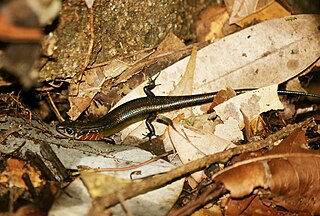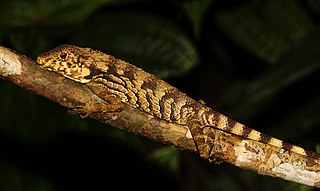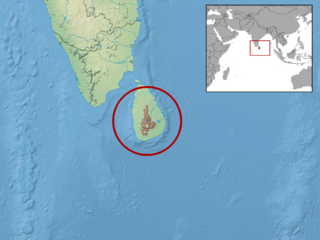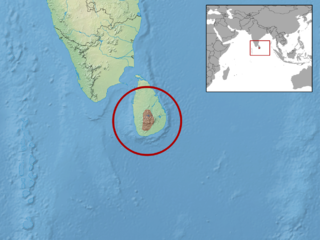
Lankascincus is a genus of lizards, commonly known as lanka skinks and tree skinks, in the family Scincidae. The genus is endemic to Sri Lanka.
The Haly's tree skink is a species of lizard in the family Scincidae. The species is native to Sri Lanka. Earlier thought to be found also in the Western Ghats, taxonomic studies have shown D. haliana to be a Sri Lankan endemic, differentiated from the Indian D. subcaeruleum. D. haliana is the only arboreal skink in Sri Lanka.
Eutropis dawsoni, also known commonly as Gans's grass skink and Gans's mabuya, is a species of lizard in the family Scincidae. The species is endemic to the southern Western Ghats, India.

Ceratophora erdeleni, also known commonly as Erdelen's horned lizard or Erdelen's horn lizard, is a species of lizard in the family Agamidae. The species is endemic to Sri Lanka. It has only a rudimentary "horn", that is occasionally missing altogether.
Ceratophora karu, also known commonly as Karu's horned lizard or Karunaratne's horn lizard, is a species of lizard in the family Agamidae. The species is endemic to Sri Lanka.
Calotes desilvai, commonly known as the Morningside lizard, or the Ceylon black-band whistling lizard, is a species of lizard in the family Agamidae. Calotes desilvai is one of seven Calotes species endemic to Sri Lanka.
Cnemaspis kumarasinghei, commonly known as Kumarasinghe's day gecko, is a species of lizard in the family Gekkonidae. The species is endemic to the island of Sri Lanka.
Thwaites's skink, also known commonly as the fourtoe snakeskink, is a species of skink, a lizard in the family Scincidae. The species is endemic to the island of Sri Lanka.

Lankascincus deignani, commonly known as Deignan's tree skink and the Deignan tree skink, is a species of lizard in the family Scincidae. The species is endemic to the island of Sri Lanka.

Lankascincus fallax, also known commonly as the common supple skink and Peters's tree skink, is a species of lizard in the family Scincidae. The species is endemic to the island of Sri Lanka.

Lankascincus taprobanensis, also known commonly as the Ceylon tree skink and the smooth Lanka skink, is a species of lizard in the family Scincidae. The species is endemic to the island of Sri Lanka.
Lankascincus taylori, commonly known as Taylor's tree skink, is a species of lizard in the family Scincidae. The species is endemic to the island of Sri Lanka.
Lankascincus dorsicatenatus, also known as the catenated lankaskink, is a species of skink, a lizard in the family Scincidae. The species is endemic to island of Sri Lanka.
Eutropis floweri, also known commonly as Flower's skink, Taylor's skink and Taylor's striped mabuya, is a species of lizard in the family Scincidae. The species is endemic to the island of Sri Lanka. It is probably named after Stanley Smyth Flower.
Eutropis madaraszi, also known commonly as the Sri Lanka bronze mabuya, the Sri Lanka bronze skink, or (ambiguously) the spotted skink, is a species of lizard in the family Scincidae. The species is endemic to the island of Sri Lanka.
Nessia deraniyagalai, commonly known as Deraniyagala's snake skink, Deraniyagala's snakeskink, or Deraniyagala's nessia, is a species of limbless lizard in the family Scincidae. The species is endemic to the island of Sri Lanka.
Nessia didactyla, also known commonly as the two-toed nessia and the two-toed snakeskink, is a species of skink, a lizard in the subfamily Scincinae of the family Scincidae. The species is endemic to the island of Sri Lanka.
Nessia layardi, commonly known as Layard's snake skink or Layard's nessia, is a species of lizard in the subfamily Scincinae of the family Scincidae. The species is endemic to the island of Sri Lanka.
Nessia gansi, also known commonly as Gans's three-toed snake skink, is a species of lizard in the family Scincidae. The species is endemic to the island of Sri Lanka.
Lankascincus sameerai, commonly known as Sameera's lanka skink, is a species of lizard in the family Scincidae. The species is endemic to the island of Sri Lanka.






